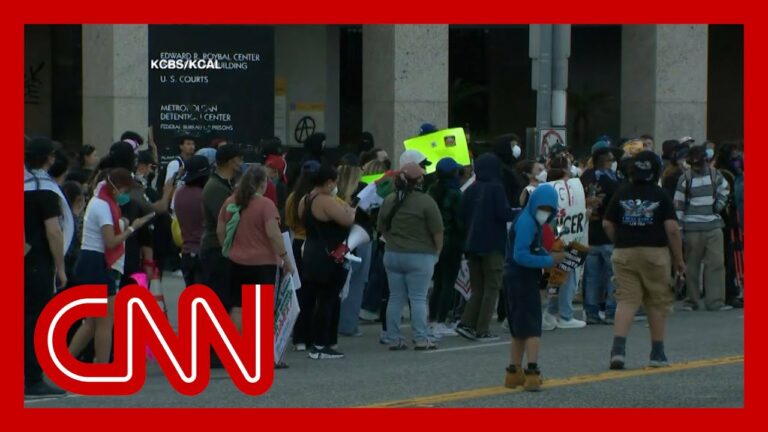Video at the bottom!
Protests have erupted in the Los Angeles area as demonstrators take to the streets for the second consecutive night, voicing their opposition to immigration enforcement policies. Tensions escalated between protesters and law enforcement, with the LAPD deploying flashbangs and tear gas in efforts to disband crowds. In response to the unrest, the Trump administration announced the deployment of 2,000 National Guardsmen to the area, a decision criticized by California’s governor as inflammatory.
CNN reporter Julia Vargas Jones is on the ground in downtown Los Angeles, where a large crowd is demonstrating outside the Federal Building. Protesters are chanting slogans such as “Out with ICE” and calling for the release of individuals detained during recent immigration raids. Approximately 118 people are reported to have been arrested in various protests throughout the week, including incidents in Paramount where community members intervened to disrupt potential ICE raids.
The situation has drawn further attention, particularly related to the high-profile case of David Grant, an activist and union leader arrested during the protests. Governor Gavin Newsom has publicly voiced concerns that federal troops might exacerbate the already tense situation, noting the protests, while significant, remain relatively small in scale.
Vargas Jones highlights the dispersed nature of the protests, with some occurring as far south as Compton, where a car was reportedly set on fire by protesters waving Mexican flags. This underscores the targeted locations of protests against ICE operations in areas where raids have been anticipated.
Joining the discussion, CNN senior national security analyst Juliette Kayyem emphasized the historical context of federal troop deployment. She noted that typically, the National Guard is called upon in cases of significant crises, such as natural disasters or civil rights violations. The use of 2,000 National Guardsmen to manage protests raises questions about the need for such a show of force, especially given the relatively calm nature of the protests.
Kayyem explained that the federalization of the National Guard means they would report directly to the president, bypassing state authority. This shift is unusual, and without clear rules of engagement or operational plans, there are concerns regarding potential conflict between federal troops and local law enforcement. Historically, large-scale federal interventions were prompted by states overwhelmed by crises, not merely civil unrest.
The arrival of federal troops may escalate tensions rather than alleviate them, considering the already fraught dynamics between protesters and law enforcement. Without established guidelines, there are fears that this intervention could lead to further unrest.
As the situation evolves, both Vargas Jones and Kayyem remain on the ground, providing insights into a complex and unprecedented moment in local governance and federal authority. The eyes of the nation are watching closely as these developments unfold, raising critical questions about civil rights, government authority, and community response to federal immigration enforcement.


